Avignon
![]()
The title of this article is ambiguous. For other meanings, see Avignon (disambiguation).
Avignon [aviˈɲɔ̃] (oc. Avinhon or Avignoun [aviˈɲũn]) is a city and commune in Provence in southern France on the eastern bank of the Rhône River with 91,729 inhabitants (as of 1 January 2018), of whom about 15,000 live within the city walls. Avignon is the seat of the prefecture and the largest city in the department of Vaucluse.
Since Avignon was the papal seat from 1309 to 1376 - and during the subsequent Occidental Schism - the city is nicknamed the "City of the Popes". The old town of Avignon with its magnificent medieval houses is surrounded by an intact and imposing fortification wall. The old town with the Gothic Papal Palace (Palais des Papes) from the 14th century, the bishop's residence, the Rocher des Doms and the famous bridge, the Pont Saint-Bénézet, is a UNESCO World Heritage Site. The latter is on everyone's lips thanks to a popular song.
Artistically and culturally, the city is also known far beyond France through the Avignon Festival. In 2000, Avignon was the European Capital of Culture.
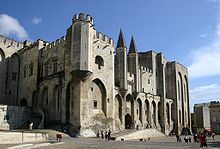
View of the New Palace
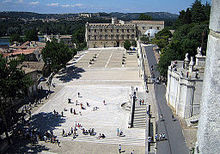
The square of the Papal Palace with the Petit Palais in the background of the square; behind it the plain of the Rhone and the Pont Saint-Bénézet; behind it the Fort Saint-André of Villeneuve-lès-Avignon
Geography

enlarge and show information about the picture
![]()
Avignon, seen from the Île de la Barthelasse
Location
Avignon is located at the confluence of the Rhône and the Durance, which flows along the south of the commune and also forms the border with the department of Bouches-du-Rhône. The Rhône is located to the west of the commune and forms the border with the department of Gard.
Neighboring communities
Neighbouring to the east and north are the municipalities of Caumont-sur-Durance, Morières-lès-Avignon, Le Pontet and Sorgues.
To the west, Avignon borders the municipalities of Villeneuve-lès-Avignon and Les Angles, which are part of the Gard department, while to the south lies the department of Bouches-du-Rhône with the municipalities of Barbentane, Rognonas, Châteaurenard and Noves.
The nearest major cities are Orange (in the north), Nîmes and Montpellier (in the southwest), Arles (in the south), Salon-de-Provence and Marseille (in the southeast).
Geology
The region in which Avignon is located is very rich in limestone. Especially common is the "molasse burdigalienne", from which, for example, the present city wall of Avignon was built.
The most important calcareous elevation of the Urgonian type is the Rocher des Doms within the town walls. The calcareous massif is distributed around the municipality (Massif des Angles, Villeneuve-lès-Avignon, Alpilles) and is partly the result of the oceanization of the Ligurian-Provencal depression, which followed the movement of the Corsican-Sardinian continental block.
Another elevation of Avignon is the wooded hill of Montfavet in the east of the commune.
The Rhône valley has ancient alluvial soils: a large part of the soil there is covered by a loose deposit composed of sandy silt. This is more or less coloured by pebbles, mainly derived from siliceous rocks. The islands of the Rhône, including Île de la Barthelasse, were formed by the accumulation of alluvial deposits and by human intervention. The relief is not very pronounced, but the mounds that have been formed are able to provide sufficient protection for the islands during floods.
The soils found in the vicinity of the town are mainly clay, silt, sand and lime.
As the occurrence of fissures in the calcareous substrate shows, there have been tectonic activities that have triggered earthquakes in the various geological eras. The last earthquake of significant magnitude took place on 11 June 1909. Traces of this are still visible in the city centre and most clearly on the bell tower of the Augustinian Church in the Rue Carreterie, which is slightly tilted as a result of the earth tremor.
See also: Earthquake in Provence 1909
Hydrography
The Rhône passes by the western edge of the city, but is divided into two arms: one speaks of the "small Rhône" or "dead arm" for the part that touches Avignon and of the "great Rhône" or "living arm" for the western part that touches Villeneuve-lès-Avignon in the Gard department. Between them is a series of islands, including Île de la Barthelasse as the largest. A canal has been built parallel to the Rhône.
The banks of the Rhône and the island of Barthelasse can be affected by floods during the autumn and mid-March. Maurice Champion mentioned some of them in 1861. By 1862, the flood of 1856, which destroyed part of the city walls, was one of the most devastating. Others occurred in 1935 and in January 1955. Floods are still a serious problem today, as most recently demonstrated by the flooding of 2 December 2003. For this reason, a new cartographie du risque has also been drawn up.
The Durance, which flows along the southern border of the commune, joins the Rhône and marks the border with the department of Bouches-du-Rhône.
In the municipality of Avignon, there are several natural or artificial water bodies such as the lac de Saint-Chamond in the east of the city.
The city has numerous canals, which can sometimes form a complex canal system. The canals were built over time and were once used to irrigate the farmland and supply the moats that surrounded Avignon.
In the 10th century, part of the water of the Sorgue d'Entraigues was diverted, which today flows under the city walls to the city centre. The watercourses were called "Canal de Vaucluse", but the inhabitants still call it "la Sorgue" or "Sorguette". It is visible in the city center along the famous Rue des Teinturiers (Cloth Dyer's Lane). It supplied the moats of the first city walls, then the new eastern city walls of the 14th century. In the 13th century (document of 1229), part of the water of the Durance was diverted to reinforce the supply systems of the moats and then to be channelled to Bonpas. These watercourses were later called "la Durançole". The Durançole supplied the western moats of the city. They were also used to irrigate the farmland of Montfavet. In the city centre, these watercourses are mostly hidden under the streets or the residential buildings and are now used as sewers.
In addition, the Canal de l'Hôpital (which joins the Durançole) and the Canal de Crillon (1775) were dug, which irrigated the areas of Montfavet, Le Pontet and Vedène. The two canals divide into numerous "vials" (Provençal filhòlas or fiolo). The Canal Puy (1808), which irrigated the former gardens to the south of Avignon, was constructed in the same way. All these canals drain the waters of the Durance and were initially used to flood the once very stony soils and fertilize them with the limestone deposits.
The canals also served to drive numerous mills.
Climate
Avignon is influenced by the Mediterranean climate. Precipitation occurs in a rhythm of four phases: two dry seasons (a short one at the end of winter and a very long and pronounced one in summer) and two rainy ones (one in autumn with abundant rain up to cloudbursts and one in spring). Summers are warm and dry under the influence of subtropical high pressure systems, but are interrupted by sometimes violent thunderstorms. Winters are mild with little precipitation and only rare snowfall.
According to Météo-France, there are an average of 45 days per year with more than 2.5 litres of precipitation per square metre. In total, the average annual rainfall is 660 l/m². Average temperatures range from 0 °C to 30 °C, depending on the season. The record temperatures since the INRA station records are 40.5 °C during the 2003 European heatwave on 5 August 2003 (and 39.8 °C on 18 August 2009) and -12.8 °C on 5 January 1985, meteorological values measured at Agroparc d'Avignon.
The main wind is the Mistral, which can sometimes reach wind speeds of 110 km/h. It blows between 120 and 160 days a year, with an average speed of 90 km/h per gust. The following table shows the different speeds of the mistral recorded at the stations of Orange and Carpentras-Serres in the south of the Rhône valley, and its frequency during 2005 and 2006. The normal values are based on the average of the last 53 years for the weather stations in Orange and on the average of the last 42 years for Carpentras.
| Monthly average temperatures and precipitation for Avignon
Source: MSN Météo | |||||||||||||||||||||||||||||||||||||||||||||||||||||||||||||||||||||||||||||||||||||||||||||||||||||||||||||||||||||||||||||||||||||||||||||||||||||||||||||||||||||||||||||||||
.jpg)
Violent summer thunderstorm over Avignon (July 2000)
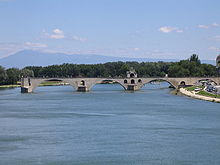
The Pont d'Avignon on the "little Rhône", in the background the Mont Ventoux

Bridges over the "Great Rhone
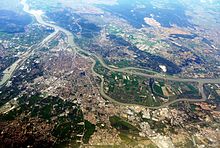
Aerial view of Avignon
_Avignon,_by_JM_Rosier.JPG)
Slate bell tower of the Augustinian church
History
→ Main article: History of the city of Avignon
Ancient
The settlement of the area around Avignon dates back to the Neolithic period, to the fourth millennium BC. The first traces of settlement were found on the steep rocky hill Rocher des Doms, which protected the inhabitants both from enemies and from the regular floods of the Rhône.
Somewhat later, the Celtoligurian warrior and fisherman people of the Kavars founded a first fortified settlement called Aouenion, which means "Lord of the Waters".
Thanks to its favourable strategic position, in the sixth or fifth century B.C. the Phocaeans of Marseilles created a fortified river port and a transhipment point (emporion) called Avenio, mainly to receive goods shipped downriver. The new name meant something like "city of the mighty winds" and is also found minted on coins.
Under Roman rule, which began in 48 BC, the river port was expanded and the city was renamed Colonia Iulia Augusta Avenionesium. In addition, the city was expanded into a flourishing commonwealth. Emperor Hadrian granted it the status of a Roman colony.
Only a few remains of the Roman city have been preserved. Only parts of a portico and a forum still bear witness to the ancient architecture. Most of the buildings were probably destroyed or built over at the time of the popes.
Early and High Middle Ages
Christianisation was possibly carried out at the end of the third century. Outside the city walls, a small Christian community existed, which is considered the precursor of Saint-Ruf Abbey.
During the migration of peoples Avignon lost its importance. Wars and epidemics caused a decline in the population, so that only a small district around the Rocher des Doms remained populated. In 737, the city allied itself with the Saracens invading Provence. In retaliation, the Battle of Avignon resulted in the conquest by Charles Martell's troops, who burned the city to the ground.
Thereafter, the development of feudalism and a long-lasting period of peace set in. The rule of the city was divided between the bishop, who had his own palace next to the cathedral, and the Count of Provence, who resided on the top of the Rocher des Doms.
In 932, the kingdoms of Provence and High Burgundy formed the Kingdom of Arelat, in which Avignon became one of the most important cities. With the annexation of the Kingdom of Arles to the Holy Roman Empire in 1032, Avignon and Provence came under the control of the German Emperor. From now on, the Rhône formed the new western border of the empire to the kingdom of France and could only be crossed over the old wooden bridge near Avignon.
In the twelfth century, Avignon achieved the status of a self-governing city republic on the Italian model. During this period, a first ring of walls and the St. Bénézet bridge were built, making the city an important transit point in the south of France.
At the time of the Albigensian Wars, the city fought on the side of the Albigensians and refused passage to King Louis VIII in 1226, leading to the siege of Avignon. Avignon was starved for three weeks and eventually had to surrender. There was destruction of the fortifications and severe damage to the bridge.
Around 1250, Louis' brother Charles I of Anjou abolished local self-government again and put the city back under count's rule. Since 1290 it belonged to the Count of Provence Charles II of Anjou, who was also King of Naples and a loyal vassal of the Church.
As early as 1303, even before the arrival of the popes, Pope Boniface VIII founded the University of Avignon in competition with the Sorbonne in Paris.
Avignon Papacy
→ Main article: Avignonese papacy
At the beginning of the fourteenth century, power struggles in Rome led to Avignon becoming the seat of the popes and thus the capital of Christianity for seventy years. After the short pontificate of Benedict XI, who had already died in 1304, his successor Clement V, with the support of the French king Philip the Fair, had himself crowned as the first pope on French soil. After the coronation in Lyon, the papal residence was first moved to the county of Venaissin, which had been papal property since the end of the Cathar Crusades. In 1309 the move to Avignon took place. Clement's successor John XXII, previously bishop of Avignon, first took up his permanent residence in the episcopal palace. Benedict XII, a highly educated Cistercian, had the first part of the Papal Palace (Old Palace) built. Clement VI, who was considered fond of pomp and art, built the New Palace. He also bought the city in 1348 for 80,000 gold florins from Joan I of Naples, thus annexing Avignon to the Papal States. Innocent VI, who held office from 1352 to 1362, is to thank for the present city walls.
Already Urban V tried to return to Italy, but only Pope Gregory XI managed to prevail against the French king and move the seat back to Rome in 1377. He received moral support from Catherine of Siena, who helped him end the exile. As the French cardinals were dissatisfied with the election of his successor Urban VI, they elected Clement VII as antipope, who again exercised his office from Avignon. This election set in motion the Great Western Schism, which led to the schism of the Catholic Church and was not ended again until the Council of Constance in 1414. Benedict XIII was the last pope to exercise his pontificate in Avignon from 1394 to 1417. A total of seven Roman popes resided in the city, as well as two counter-popes who were not recognized by the Catholic Church.
The transfer of the papal seat to Avignon was to have a lasting effect on the cityscape. The mighty Papal Palace was built and a defensive wall around the city. Added to this were Gothic churches, monasteries and towers, as well as impressive cardinal liveries. The new papal court became one of the most glamorous courts of the Middle Ages. With the papacy, the city began to prosper at the same time. Avignon became an intellectual, artistic and cultural centre. In the wake of the popes, many people flocked to the city, among them cardinals, clerics, nobles, craftsmen and merchants. But architects, sculptors and artists were also attracted, such as the Italian painters Matteo Giovanetti and Simone Martini and the poet Francesco Petrarca. At the time, about 30,000 people are said to have lived in the city, making Avignon one of the great cities of Western Europe.
However, not all people could benefit equally from the new wealth. While within the city walls mainly the cardinals and nobles lived in pomp and prosperity, the outer poor quarters were inhabited by more and more beggars, day laborers and prostitutes. The poor hygienic conditions favoured the outbreak of the plague in 1349, which claimed the lives of about 11,000 people. In addition, the population suffered from droughts, famines and roaming marauding soldiers of the Hundred Years War.
early modern period
After the departure of the last antipope at the beginning of the fifteenth century, Avignon and the county of Venaissin remained under the administration of a papal envoy. When Provence fell to the Kingdom of France in 1481, the city even had the status of a papal enclave on French soil.
Avignon was not spared from the Huguenot wars raging in France. After the destruction of numerous church properties by Protestants in Orange, papal troops were sent from Avignon to the city, where they carried out a massacre. In retaliation, Avignon was besieged in 1562 by the Baron des Adrets.
In the centuries that followed, until the French Revolution, Avignon enjoyed a prosperous period, with the construction of new houses, churches, monuments and hôtels. An exception was the outbreak of the Great Plague in 1721, which decimated the city, previously 24,000 inhabitants, to a quarter of its population.
French Revolution to 21st Century
The French Revolution took place in Provence, especially in the large cities of Marseille, Aix, Arles and Avignon. In 1790, Provence was divided into departments. For the formation of the département of Vaucluse, a rapid annexation of the papal territories to France was demanded in the course of the incipient dechristianization, which led to a counter-revolution in Avignon loyal to the Pope. This, however, was unsuccessful. Revolutionary troops annexed Avignon and the county of Venaissin in 1791, which thus lost its special status. In 1793, Avignon became the capital of the newly created department of Vaucluse. The revolutionary struggles led to the destruction of many architectural and artistic monuments in the city.
During the Second Empire, the cityscape underwent further changes. The rue de la République was widened, the Place Pie was enlarged and pleasure gardens were laid out along the Rocher des Doms.
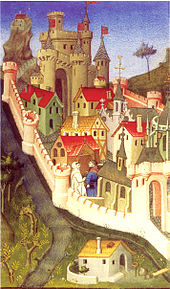
The Papal Palace and the City of Avignon, miniature painting by the Boucicaut master at the beginning of the 15th century (Bibliothèque nationale de France)
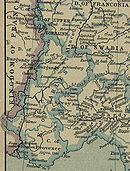
Map of the Kingdom of Arles, which was annexed to the Holy Roman Empire in 1032.
Questions and Answers
Q: What is Avignon?
A: Avignon is a commune in southeastern France in the department of Vaucluse on the left bank of the Rhône river. It is the capital (prefecture) of the Vaucluse department.
Q: What is special about Avignon?
A: The historical centre, which includes the Palais des Papes, the cathedral, and the Pont d'Avignon, became a UNESCO World Heritage Site in 1995. The medieval monuments and the annual Festival d'Avignon have helped to make it a major centre for tourism.
Q: Where is Avignon located?
A: Avignon is located in southeastern France in the department of Vaucluse on the left bank of the Rhône river.
Q: What are some attractions at Avignon?
A: Some attractions at Avignon include its historical centre with Palais des Papes, cathedral, and Pont d'Avignon; its medieval monuments; and its annual Festival d'Avignon.
Q: When did Avignon become a UNESCO World Heritage Site?
A: Avigon became a UNESCO World Heritage Site in 1995.
Q: Why has Avigon become a major centre for tourism?
A: The medieval monuments and annual Festival d'Avigon have helped to make it a major centre for tourism.
Search within the encyclopedia